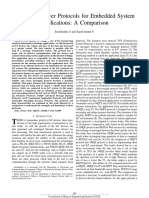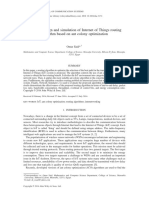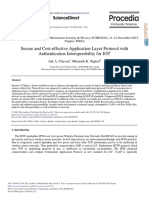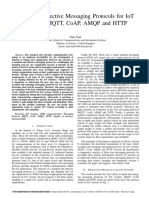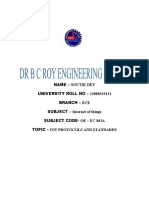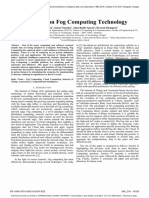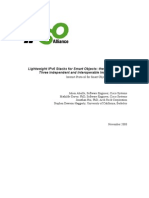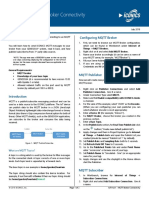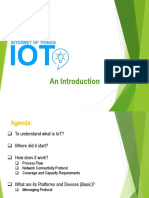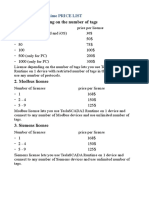Comparison of IoT Protocols Performance
Comparison of IoT Protocols Performance
Copyright:
Available Formats
Comparison of IoT Protocols Performance
Comparison of IoT Protocols Performance
Copyright
Available Formats
Share this document
Did you find this document useful?
Is this content inappropriate?
Copyright:
Available Formats
Comparison of IoT Protocols Performance
Comparison of IoT Protocols Performance
Copyright:
Available Formats
Volume 6, Issue 5, May – 2021 International Journal of Innovative Science and Research Technology
ISSN No:-2456-2165
Comparison of IoT Protocols Performance
Yaseen NADIR SUPERVISOR
Information Institution Dr. Mutlu Tahsin ÜSTÜNDAĞ
Gazi University Assoc. Prof., Gazi Faculty of Education
Ankara, Turkey Gazi University
Ankara, Turkey
Abstract:- Internet of Things, it is been more than a and MQTT in terms of traffic, packet loss probability, and
decade since this concept was introduced to the society. latency conditions. Lavinia Nastasa in her research
In this research we aim to compare three IoT application concentrates on application layer protocols; CoAP, MQTT,
protocols; Advanced Messaging Queuing Protocol and XMPP from security point of view, described briefly the
(AMQP), Message Queuing Telemetry Transport three protocols and their vulnerabilities, and according to the
(MQTT) and Constrained Application Protocol (CoAP). study, it is none of them are best for any type of solutions in
The selected protocols efficiency will be evaluated using terms of both security and functionality (Nastasa, 2017).
indicators related to Throughput and Round-Trip time Alvin VALERA and Hwee TAN, have proposed a common
(RTT). In the considered scenario an IoT device will middleware using common application programming
transfer data to a server and waits for the response. The interface, and have tested CoAP and MQTT protocols, the
data will be sent in different sizes of packets. We have research results shows that; different network conditions can
proposed a testbed using python programing language’s affects the performance of different protocols, MQTT has
library SciPy and socket programming to evaluate the lower delay for lower packet loss and vice versa, CoAP
three protocols. Experimentation tests reveal which generates less traffic to ensure reliable delivery when the
protocol is best suited for different scenarios accordingly. massage size is small and loss rate is equal or less than 25%
Results show that overall MQTT achieves the highest (Valera & Tan, 2014). In (Paolo Bellavista, Alessandro
protocols efficiency among other protocols. Zanni., 2016), the authors proposed an innovative scalable
distributed architecture for efficient IoT-cloud integration.
Keywords:- IoT, IoT Protocols, Performance, MQTT, The two selected protocols were CoAP and MQTT. The
AMQP, COAP. performance benchmark for the time required to complete
the transmission of 1000, 10000 and 60000 messages was
I. INTRODUCTION set and according to the authors, the MQTT protocol was
much faster than CoAP.
The internet is the most important and transformative
technology have ever invented, it is like digital fabric that There are several published survey papers regard IoT
woven into our lives and rapidly changed the world. application layer protocols but as IoT technology is growing
Likewise, new technology has emerged and it is poised to tremendously fast, it was important to test these application
change the world again, this technology is not about protocols with different metrics. This experiment will
connecting people or computers, it is about connecting examine the following selected application services used for
objects “The Internet of Things”. The internet of things IoT data transfer:
represents a vision wherein the net extends into the actual
world embracing daily objects. Physical objects are no A. Constrained Application Protocol (CoAP)
longer disconnected from the digital world, however these Constrained Application Protocol was created and
objects can be managed remotely and can act as physical standardized by the Internet Engineering Task Force (IETF)
access points to Internet services. In the Network of things, Constrained Restful Environment working group (CoRE).
objects can start to share experience with other objects, by CoAP is specialized internet application protocol for
adding the ability to sense, communicate to control and constrained nodes and networks based on Representational
collaborate with each other, things that are connecting to the State Transfer (REST) (Shelby, Z; Hartke, K; Bormann,
internet allowing them to generate, send, receive and 2014). CoAP is a RESTful application protocol but in order
exchange data. to understand CoAP clearly the REST concept must be
introduced first. Representational State Transfer (REST) is a
IoT communication protocols are a subject of many web architectural style. RESTful systems are classified as
studies in research community. Bhattacharyya et al. (Soma they are stateless and separate concerns of client and servers.
Bandyopadhyay, Abhijan Bhattacharyya., 2013) have done a REST architecture is request-response architecture, client
comparison between CoAP's request-response model and sends request to server in order to get to stored resources in
MQTT publish-subscribe model. Application layer rules for it and these each resource has a Uniform Resource Identifier
IoT are explored in (Sotirios Kontogiannis, Angelos (URI) as an address. In case where server response, a
Chatzimparmpas, George Kokkonis., 2015); here, the content-type must be included in the header of the response.
authors have presented quantitative examinations of CoAP Unlike REST, CoAP uses datagram-oriented transport such
IJISRT21MAY311 www.ijisrt.com 556
Volume 6, Issue 5, May – 2021 International Journal of Innovative Science and Research Technology
ISSN No:-2456-2165
as UDP layer to keep design simple, with a primary goal of is done according to its design. Since the MQTT protocol is
providing communication that works between devices with based on TCP/IP and it is implementations responsibility to
limited resources or networks with low bandwidth. CoAP provide appropriate security and integrity, security features
supports the use of multicast IP destination addresses, must be implemented on top of MQTT. This can be
enabling multicast CoAP requests. The CoAP message achieved by using Transport Layer Security TLS/Secure
format is encoded in Binary format (Shelby, Z; Hartke, K; Socket Layer SSL. Authentication is based on certificates
Bormann, 2014). CoAP message format starts with four and privacy is based on encryption mechanism by the
fixed-size 4 bytes header consisting five fields. As CoAP application.
runs over UDP, it is secured using Datagram Transport Objectives of the Study;
Layer Security. - Evaluating and comparing the performance of IoT
protocols for different network scenarios.
B. Advance Messaging Queuing Protocol (AMQP) - Is protocol efficiency affected by different conditions of
The Advance Messaging Queuing Protocol is a binary the network?
and an open standard application layer protocol for message - Is the Round Trip Time affected by network conditions?
oriented middleware. It is been designed to provide peer-to-
peer (point-to-point and publish and subscribe) routing, Although there are many studies on the Internet of
message orienting, queuing, reliability based on underlying Things, It is believed that there are still a need for
on transport layer protocol such as Transmission Control performance analysis studies in different conditions of
Protocol (TCP), security based on Simple Authentication different networks. Given the significant impact of this
and Security Layer (SASL) and Transport Layer Security situation, more studies are needed. In this study, evaluation
(TLS). The Advanced Message Queuing Protocol (AMQP) of the effectiveness of IOT protocols and comparison will be
was released by various financial institutes and software examined. Information about the selected protocols will be
companies in 2006 and was standardized by OASIS1 in the collected based on the previous studies, these protocols will
year 2012 (Turowski, Bosse, Kubela, & Pohl, 2018). be evaluated and analyzed with the proposed testbed and
comparisons will be revealed within the framework of the
AMQP’s main components are clients and servers determined indicators.
(brokers). Broker consist of: exchanges, message queue and
binding, message routing occur using these three The methodology of obtaining, testing and analyzing
components. Exchange receives messages from publisher data is based on several stages:
and rout it to the appropriate queue. Message Queue stores Firstly: Learning and studying IoT protocols MQTT,
the messages until the meant consumer client (subscriber) AMQP, COAP and these studies will be used for scientific
processes it safely. Biding, defines the relationships between research.
exchanges and queues. There are two security approaches Secondly: Designing the proposed testbed with different
provided by AMQP: Transport layer Security (TLS), and scenarios using python programming language.
Simple Authentication and Security Layer SASL. Thirdly: implementing, simulating, and testing IoT
protocols.
C. Message Queue Telemetry Transport (MQTT) Fourthly: After the implementation and testing of the
MQTT is message-oriented protocol, a client server protocol, the data will be analyzed using Anaconda
publish-subscribe message transport protocol. It is an environment to facilitate the qualitative analysis process.
extremely light-weight, open, simple, designed to be easy to
implement for high-latency or unreliable network II. EXPERIMENTAL DESIGN
(Konstantinos, et al., 2016).The MQTT protocol run over
TCP/IP networks. MQTT was created by IBM then In this section, we discuss the implementation of the
standardized by OASIS. The publish-subscribe model of proposed testbed and evaluate the performance of its
MQTT is based on the Client-Server model, and the server is proposed algorithm with different routing protocols, e.g.
more like a broker or gateway, an MQTT Broker is a device AMQP, MQTT, and COAP.
that acts as intermediary between client which publish and
client which has made subscription. MQTT delivers The proposed software consists of three structures.
application messages with three QoS levels: They are the IoT sensor structure, the gateway module
QoS 0: “At most once”, where the message is delivered structures, and the cloud application server structures. The
but no response is sent by the receiver and no resend first structure is the IoT sensor, where the proposed software
message is performed by the sender, lost can occur. simulates a light version of the IoT device, which generates
QoS 1: “At least once”, this QoS enures the delivery of packets in three different packet formats represent the
message to the receiver at least once, duplicated can routing protocols, i.e., COAP, MQTT, and AMQP. The
occur. second structure is the gateway module, which is up and
QoS 2: “Exactly once delivery”, this is where the waiting to sniff different packets coming from a group of
message is assured to arrive at the receiver with no loss IoT sensors and forward them to the cloud application server
or duplication, it is the highest level of QoS. acting as the man in the middle. The third structure is the
cloud application server, which is up and running tending on
The important part is that there is no security features its listening port to receive connection requests from the
in MQTT specifications, the security of each implementation
IJISRT21MAY311 www.ijisrt.com 557
Volume 6, Issue 5, May – 2021 International Journal of Innovative Science and Research Technology
ISSN No:-2456-2165
gateway. This server represents the Application Enablement Figure 2 depicts the upstream and downstream
Platform (AEP) in the IoT value chain. throughput of the gateway in the case of AMQP routing
protocol. It shows that downstream throughput is almost four
In our simulation, the performance evaluation of the times higher than upstream throughput. Also, as the total
proposed algorithm has been achieved taking into number of packets sent by IoT devices increases, the
consideration the following evaluation metrics: upstream and downstream throughput of the gateway
• Upstream processing delay: it is the execution time to decreases slightly.
decapsulate the IoT device packet header, encapsulate the
payload into the TCP/UDP header and send the packet to the
cloud application server.
• Downstream processing delay: it is the execution time to
decapsulate the TCP/UDP header, encapsulate the payload
into the IoT device packet header and send the reply back to
the corresponding IoT device.
• Average processing delay: it is the round-trip processing
time to process the IoT device packet while traveling in both
upstream and downstream directions.
• Upstream throughput: it is the total number of packets per
second that the gateway can handle in the upstream direction
from the IoT device to the cloud application server.
• Downstream throughput: it is the total number of packets
per second that the gateway can handle in the downstream
direction from the cloud application server to the IoT device. Figure 2: The relation between throughput and number of
connected devices in AMQP.
III. RESULTS AND DISCUSSION
E. Message Queuing Telemetry Transport (MQTT)
We have tested the performance by changing the Figure 3 shows that in the MQTT protocol, the average
number of packets sent by IoT devices, and check the upstream processing delay is shorter than the average
average processing delay of the upstream, the downstream, downstream processing delay. It means that the packet
and the round-trip processing delay, besides the upstream decapsulation from MQTT packets and encapsulation into
and downstream throughput. the TCP/UDP header takes lower processing time than
decapsulating the payload from the TCP/UDP header and
D. Advanced Messaging Queuing Protocol (AMQP) encapsulating it into the MQTT header.
Figure 1 shows that in AMQP protocol, the average
upstream processing delay is shorter than the average Besides, as the total number of connected devices
downstream processing delay. It means that the packet increases, the upstream processing delay is almost constant
decapsulation from AMQP packets and encapsulation into for different numbers of connected devices, while the
the TCP/UDP header takes lower processing time than downstream processing time increases, accordingly the total
decapsulating the payload from the TCP/UDP header and average round-trip processing delay increases as well. This
encapsulating it into the AMQP header. Moreover, increasing means the total number of connected devices and the
the total number of packets sent from the IoT devices doesn’t downstream processing time have a direct effect on the
have a high effect on the average upstream processing delay, scalability performance.
while it has a high effect on the downstream processing
delay, accordingly downstream processing delay has a direct
effect on the total round-trip processing time.
Figure 1: The relation between average processing delay and Figure 3: The relation between average processing delay and
number of connected devices in AMQP. number of connected devices in MQTT.
IJISRT21MAY311 www.ijisrt.com 558
Volume 6, Issue 5, May – 2021 International Journal of Innovative Science and Research Technology
ISSN No:-2456-2165
Figure 4 depicts the upstream and downstream Figure 6 shows the upstream and downstream
throughput of the gateway in the case of the MQTT routing throughput of the gateway in the case of COAP routing
protocol. It shows that downstream throughput is almost protocol. It shows that downstream throughput is almost six
seven times higher than upstream throughput. Also, as the times higher than upstream throughput. Also, as the total
total number of packets sent by IoT devices increases, the number of packets sent by IoT devices increases, the
downstream throughput of the gateway decreases slightly. downstream throughput of the gateway decreases.
Figure 4: The relation between throughput and number of Figure 6: The relation between throughput and number of
connected devices in MQTT. connected devices in COAP.
F. Constrained Application Protocol (COAP) Figure 7 shows the relation between the average
Figure 5 shows that in COAP protocol, the average processing delay and the number of connected IoT devices
upstream processing delay is shorter than the average for AMQP, MQTT, and COAP routing protocols. It is
downstream processing delay. It means that the packet obvious that for small traffic volume, e.g., 150 connected
decapsulation from COAP packets and encapsulation into devices, AMQP routing protocol has the highest average
the TCP/UDP header takes lower processing time than round-trip processing delay among other routing protocols.
decapsulating the payload from the TCP/UDP header and COAP routing protocol comes second, and then MQTT has
encapsulating it into COAP header. the lowest average round-trip processing delay. While for
the high traffic volume, e.g., 550 connected devices and
Also, as the total number of connected devices beyond, AMQP routing protocol provides lower round-trip
increases, the upstream processing delay is almost constant processing delay than COAP, however MQTT still the
for different numbers of connected devices, while the lowest round-trip processing delay among other routing
downstream processing time increases, accordingly the total protocols.
average round-trip processing delay increases as well. This
means the total number of connected devices and the
downstream processing time have a direct effect on the
average round-trip processing delay.
Figure 7: The relation between average processing delay and
number of connected devices for all routing
On the other hand, Figure 8 depicts the relation
Figure 5: The relation between average processing delay and between the upstream and downstream throughput with the
number of connected devices in COAP. total number of connected IoT devices for AMQP, MQTT,
and COAP routing protocols. It is obvious that there is no
IJISRT21MAY311 www.ijisrt.com 559
Volume 6, Issue 5, May – 2021 International Journal of Innovative Science and Research Technology
ISSN No:-2456-2165
high difference in the upstream throughput for all routing REFERENCES
protocols, as they are almost closed to each other. While in
the downstream throughput, the results show that the MQTT [1]. Konstantinos, Fysarakis, Ioannis Askoxylakis, Othonas
routing protocol has the highest throughput, and COAP is Soultatos, Ioannis Papaefstathiou, Charalampos
the second highest, then AMQP is the lowest throughput Manifavas, and Vasilios Katos. 2016. "Which IoT
among all routing protocols. Protocol? Comparing standardized approaches over a
common M2M application."
[2]. Nastasa, Lavinia. 2017. "Security in the Interner of
Things: A survey on Application Layer Protocol."
[3]. Paolo Bellavista, Alessandro Zanni. 2016. "Towards
Better Scalability for IoT-Cloud Interactions." IEEE
2nd International Forum on Research and
Technologies for Society and Industry Leveraging a
better tomorrow (RTSI).
[4]. Shelby, Z; Hartke, K; Bormann. 2014. "The
Constrained Application Protocol (CoAP)." RFC 7252.
[5]. Soma Bandyopadhyay, Abhijan Bhattacharyya. 2013.
"Lightweight Internet Protocols for Web Enablement
of Sensors using Constrained." International
Conference on Computing, Networking and
Communications, Workshops Cyber Physical System.
[6]. Sotirios Kontogiannis, Angelos Chatzimparmpas,
Figure 8: The relation between throughput and number of George Kokkonis. 2015. "Middleware IoT protocols
connected devices for all routing protocols. performance evaluation for carrying out clustered
data."
IV. CONCLUSION [7]. Turowski, Klaus, Sascha Bosse, Janick Kubela, and
Matthias Pohl. 2018. "Performance Evaluation of
In this research the selected application layer protocols Application Layer."
of Internet of things are been simulated using the proposed [8]. Valera, Alvin Cerdeva, and Hwee Xian Tan. 2014.
testbed software and number of tests with different volume "Performance Evaluation of MQTT and CoAP.
traffics were run on the three protocols performance.
The results show that for low volume round-trip time,
every protocol has almost the same round-trip processing
delay. While the number of packets increases the difference
between the protocols increases too, as a result for high
volume round-trip time, MQTT has the lowest average
round-trip processing delay among other protocols.
Likewise, the upstream throughput results clearly show there
is no high difference between all protocols, as every protocol
almost close to each other. While according to the results of
the tests, MQTT protocol became the highest throughput
among the protocols in terms of downstream throughput.
Experimental results showed that the performance of
different protocols are dependent on different network
conditions. Also, one of the most important points that is
been observed that the header size of each protocol plays a
big role in the efficiency of the routing protocol, as a fixed
size payload is been used for all tests.
IJISRT21MAY311 www.ijisrt.com 560
You might also like
- Batra N., Goyal S. IoT Fundamentals With A Practical Approach 2025Document289 pagesBatra N., Goyal S. IoT Fundamentals With A Practical Approach 2025harbhajan.trpmNo ratings yet
- IoT Project ReportDocument24 pagesIoT Project ReportAatithya VoraNo ratings yet
- Communication Protocol Stack For Constrained Iot SystemsDocument6 pagesCommunication Protocol Stack For Constrained Iot SystemsDorothy ManriqueNo ratings yet
- A Comparison of Iot Application Layer Protocols Through A Smart Parking ImplementationDocument7 pagesA Comparison of Iot Application Layer Protocols Through A Smart Parking ImplementationNoobstaxD AhmedNo ratings yet
- SSRN Id3791124Document6 pagesSSRN Id3791124Nilesh GopnarayanNo ratings yet
- A Comprehensive Study of Communication Protocols of Internet of ThingsDocument8 pagesA Comprehensive Study of Communication Protocols of Internet of ThingsNaveed AfzalNo ratings yet
- MQTT VS CoapDocument7 pagesMQTT VS CoapNandita ThukralNo ratings yet
- Iot Protocols 07496622Document7 pagesIot Protocols 07496622paulo vidalNo ratings yet
- MQTT VulneribilitiesDocument6 pagesMQTT VulneribilitiesAbdul HadiNo ratings yet
- Applied Sciences: A Performance Analysis of Internet of Things Networking Protocols: Evaluating MQTT, Coap, Opc UaDocument30 pagesApplied Sciences: A Performance Analysis of Internet of Things Networking Protocols: Evaluating MQTT, Coap, Opc UaLEE ALVAREZNo ratings yet
- A Survey On Application Layer Protocols For The Internet of Things Transaction On IoT and Cloud ComputingDocument7 pagesA Survey On Application Layer Protocols For The Internet of Things Transaction On IoT and Cloud ComputingMaria GonzalezNo ratings yet
- Internet of ThingsDocument20 pagesInternet of ThingsKonark JainNo ratings yet
- Trustbased Routing Metric for RPL Routing Protocol in the Internet of Things.Document17 pagesTrustbased Routing Metric for RPL Routing Protocol in the Internet of Things.ijansjournalNo ratings yet
- 2016 Elsevier Secure and Cost Effective Application Layer Protocol With Authentication Interoperability For IOTDocument6 pages2016 Elsevier Secure and Cost Effective Application Layer Protocol With Authentication Interoperability For IOTrobiNo ratings yet
- A Study of Iot MQTT Control Packet Behavior and Its Effect On Communication DelaysDocument10 pagesA Study of Iot MQTT Control Packet Behavior and Its Effect On Communication DelaysJohn GreenNo ratings yet
- Hameed 2021 J. Phys. Conf. Ser. 1804 012112Document13 pagesHameed 2021 J. Phys. Conf. Ser. 1804 012112Ardhendu SarkarNo ratings yet
- Choice of Effective Messaging Protocols For IoT Systems MQTT CoAP AMQP and HTTP-2Document7 pagesChoice of Effective Messaging Protocols For IoT Systems MQTT CoAP AMQP and HTTP-2so.ghost.07No ratings yet
- Guest Editorial Special Issue On Internet of Things Over LTE/LTE-A Network: Theory, Methods, and Case StudiesDocument5 pagesGuest Editorial Special Issue On Internet of Things Over LTE/LTE-A Network: Theory, Methods, and Case StudiesHadumanroNo ratings yet
- Comparative Study of Messaging Protocols Paper_it231519_GruberDocument4 pagesComparative Study of Messaging Protocols Paper_it231519_GruberasbalyanNo ratings yet
- Interoperability in The Iot - An Evaluation of The Semantic-Based ApproachDocument9 pagesInteroperability in The Iot - An Evaluation of The Semantic-Based ApproachMohammed AfnanNo ratings yet
- Abapour, 2021Document10 pagesAbapour, 2021Faisal AliNo ratings yet
- 12 Vol 97 No 19Document11 pages12 Vol 97 No 192311600122No ratings yet
- Research PaperDocument41 pagesResearch PaperSatyadeep MallickNo ratings yet
- A Q-Learning-Based Distributed Queuing Mac ProtocoDocument27 pagesA Q-Learning-Based Distributed Queuing Mac ProtocoAtul PandeyNo ratings yet
- Multipath Transmission For The Internet: A SurveyDocument39 pagesMultipath Transmission For The Internet: A Surveyanap905100% (1)
- Routing Protocols For IOT Applications Based On Distributed LearningDocument7 pagesRouting Protocols For IOT Applications Based On Distributed LearningduytanNo ratings yet
- IoT Real Time Data Acquisition Using MQTT ProtocolDocument7 pagesIoT Real Time Data Acquisition Using MQTT ProtocolHairatun NisaNo ratings yet
- Paper 380Document6 pagesPaper 380saatank1No ratings yet
- Comparison of Coap and Cocoa+ Congestion Control Mechanisms For Different Iot Application ScenariosDocument7 pagesComparison of Coap and Cocoa+ Congestion Control Mechanisms For Different Iot Application ScenariosDoris OrdoñezNo ratings yet
- School of Arts and Science: Department of Computational StudiesDocument10 pagesSchool of Arts and Science: Department of Computational StudiesJashNo ratings yet
- Research ArticleDocument10 pagesResearch ArticleRuben BaezNo ratings yet
- Iot Macprotocal IEEE PaperDocument5 pagesIot Macprotocal IEEE PaperUzair TanveerNo ratings yet
- (Soutik Dey Iot)Document7 pages(Soutik Dey Iot)Soutik DeyNo ratings yet
- 2022 Seeing Traffic Paths Encrypted Traffic Classification With Path Signature FeaturesDocument16 pages2022 Seeing Traffic Paths Encrypted Traffic Classification With Path Signature Featuresdrickv5No ratings yet
- Age of Information and Energy Consumption in Iot: An Experimental EvaluationDocument12 pagesAge of Information and Energy Consumption in Iot: An Experimental Evaluationsrinivasan.sharma.kNo ratings yet
- Simulation of RPL in Iot Network Using Cooja SimulatorDocument4 pagesSimulation of RPL in Iot Network Using Cooja SimulatorSaurabhNo ratings yet
- A Robust Comparative Analytical Study of NICs and Its Effect On Internet Network ServicesDocument19 pagesA Robust Comparative Analytical Study of NICs and Its Effect On Internet Network ServicesInternational Journal of Innovative Science and Research TechnologyNo ratings yet
- Survey On Recent Advances in IoT Application Layer Protocols PDFDocument18 pagesSurvey On Recent Advances in IoT Application Layer Protocols PDFnaseemNo ratings yet
- Choice of Effective Messaging Protocols For Iot Systems: MQTT, Coap, Amqp and HTTPDocument7 pagesChoice of Effective Messaging Protocols For Iot Systems: MQTT, Coap, Amqp and HTTPKevin Nicolas Acosta OsorioNo ratings yet
- Mahimai Don Bosco 2021 J. Phys. Conf. Ser. 1964 062014Document7 pagesMahimai Don Bosco 2021 J. Phys. Conf. Ser. 1964 062014vpsampathNo ratings yet
- Pingale-Shinde2021 Article Multi-objectiveSunflowerBasedGDocument22 pagesPingale-Shinde2021 Article Multi-objectiveSunflowerBasedGfazilet benmansourNo ratings yet
- UNIT-1: Introduction To IOTDocument122 pagesUNIT-1: Introduction To IOTJatin PrajapatNo ratings yet
- 1806-Article Text-3384-1-10-20210408Document13 pages1806-Article Text-3384-1-10-20210408anand.dhawaleNo ratings yet
- Security Analysis of Handover Key Management in 4G LTE/SAE NetworksDocument4 pagesSecurity Analysis of Handover Key Management in 4G LTE/SAE NetworksadredNo ratings yet
- Performance Analysis of CoAP 6LoWPAN and RPL Routing Protocols of IoT Using COOJA Simulator - 3Document9 pagesPerformance Analysis of CoAP 6LoWPAN and RPL Routing Protocols of IoT Using COOJA Simulator - 3Galih Yudha PratamaNo ratings yet
- 13 在线加密流量分类 有无代码Document14 pages13 在线加密流量分类 有无代码ifanxi1998No ratings yet
- A Review On Fog Computing Technology - 1 - ConferenceDocument6 pagesA Review On Fog Computing Technology - 1 - ConferenceMuhammad Atiq Ur Rehman 22-FET/PHDEE/S19No ratings yet
- Iot Ass - 3Document7 pagesIot Ass - 3PALAKURTHI VAMSHI HU21EECE0100134No ratings yet
- Sensors: Coap-Based Mobility Management For The Internet of ThingsDocument23 pagesSensors: Coap-Based Mobility Management For The Internet of ThingsAdam TanNo ratings yet
- Routing in The Internet of ThingsDocument6 pagesRouting in The Internet of ThingsArdhendu SarkarNo ratings yet
- Energy Optimization of SustainDocument8 pagesEnergy Optimization of SustainÇağrıNo ratings yet
- How To See Through The Fog Using Peer To Peer P2P For The Internet of ThingsDocument6 pagesHow To See Through The Fog Using Peer To Peer P2P For The Internet of ThingsRafael Rubio NunezNo ratings yet
- Srinivasa A H, Siddaraju.Document5 pagesSrinivasa A H, Siddaraju.aditya.poddarNo ratings yet
- 1 ElsevierDocument9 pages1 Elseviersanaz shoaieNo ratings yet
- Lightweight Ipv6 Stacks For Smart Objects: The Experience of Three Independent and Interoperable ImplementationsDocument7 pagesLightweight Ipv6 Stacks For Smart Objects: The Experience of Three Independent and Interoperable ImplementationscjwangNo ratings yet
- Assignment Template 1Document39 pagesAssignment Template 1jlvsbhumikaNo ratings yet
- IEEE P21451-1-7: Providing More Efficient Network Services Over MQTT-SNDocument5 pagesIEEE P21451-1-7: Providing More Efficient Network Services Over MQTT-SNRafael TenfenNo ratings yet
- Paper 8907Document5 pagesPaper 8907IJARSCT JournalNo ratings yet
- 1-s2.0-S0140366423003778-mainDocument17 pages1-s2.0-S0140366423003778-mainkewpiee7No ratings yet
- An Online Learning Assisted Packet Scheduler For MPTCP in Mobile NetworksDocument16 pagesAn Online Learning Assisted Packet Scheduler For MPTCP in Mobile NetworkshughNo ratings yet
- Bandwidth Allocation for Video under Quality of Service ConstraintsFrom EverandBandwidth Allocation for Video under Quality of Service ConstraintsNo ratings yet
- Cisco Certified Network Associate (CCNA) and Cisco Certified Network Professional (CCNP): Mastering Network Automation and Programmability Study GuideFrom EverandCisco Certified Network Associate (CCNA) and Cisco Certified Network Professional (CCNP): Mastering Network Automation and Programmability Study GuideNo ratings yet
- The Impact of Price, Facilities and Experience in Maintaining the Sustainable Loyalty of Air Asia Passengers Using Satisfaction as a Mediating VariableDocument11 pagesThe Impact of Price, Facilities and Experience in Maintaining the Sustainable Loyalty of Air Asia Passengers Using Satisfaction as a Mediating VariableInternational Journal of Innovative Science and Research Technology100% (1)
- Business Employer’s Perspectives on Hiring Former Persons Deprived of Liberty in the City of Angeles, PhilippinesDocument25 pagesBusiness Employer’s Perspectives on Hiring Former Persons Deprived of Liberty in the City of Angeles, PhilippinesInternational Journal of Innovative Science and Research TechnologyNo ratings yet
- AI-Driven Algorithms: Transforming Customer Engagement with AI and Ethical Data PrivacyDocument9 pagesAI-Driven Algorithms: Transforming Customer Engagement with AI and Ethical Data PrivacyInternational Journal of Innovative Science and Research TechnologyNo ratings yet
- Phenotypic Diversity Assessment and Related Indigenous Knowledge of Yam (Dioscorea spp) in Ebonyi State, NigeriaDocument112 pagesPhenotypic Diversity Assessment and Related Indigenous Knowledge of Yam (Dioscorea spp) in Ebonyi State, NigeriaInternational Journal of Innovative Science and Research TechnologyNo ratings yet
- Sustainability in Alcohol Production: An Overview of Green Initiatives and their Impact on the IndustryDocument5 pagesSustainability in Alcohol Production: An Overview of Green Initiatives and their Impact on the IndustryInternational Journal of Innovative Science and Research TechnologyNo ratings yet
- Facial Expression-Based Emotion Detection for Adaptive Teaching in Educational EnvironmentsDocument7 pagesFacial Expression-Based Emotion Detection for Adaptive Teaching in Educational EnvironmentsInternational Journal of Innovative Science and Research TechnologyNo ratings yet
- Functionality of Google Maps and Parameter-based Efficient Eateries route DetectionDocument8 pagesFunctionality of Google Maps and Parameter-based Efficient Eateries route DetectionInternational Journal of Innovative Science and Research TechnologyNo ratings yet
- Spam Detection Using Large Datasets with Multilingual SupportDocument7 pagesSpam Detection Using Large Datasets with Multilingual SupportInternational Journal of Innovative Science and Research TechnologyNo ratings yet
- Effect of Forms and Shapes on Acoustical Quality of Ecclesiastical Buildings in NigeriaDocument10 pagesEffect of Forms and Shapes on Acoustical Quality of Ecclesiastical Buildings in NigeriaInternational Journal of Innovative Science and Research Technology100% (1)
- Application of Gestalt Theory in Interior Design Dinas Perpustakaan Dan Kearsipan Daerah Provinsi Jawa Barat (DISPUSIPDA)Document10 pagesApplication of Gestalt Theory in Interior Design Dinas Perpustakaan Dan Kearsipan Daerah Provinsi Jawa Barat (DISPUSIPDA)International Journal of Innovative Science and Research TechnologyNo ratings yet
- Enhancing Biogas Yield by Co-Digestion of Cattle Dung and Acha (Digitaria Exilis) HullsDocument8 pagesEnhancing Biogas Yield by Co-Digestion of Cattle Dung and Acha (Digitaria Exilis) HullsInternational Journal of Innovative Science and Research TechnologyNo ratings yet
- Climate Adaptation and Capturing Innovative and Best Practices of Sudan Funded Projects for Knowledge ManagementDocument6 pagesClimate Adaptation and Capturing Innovative and Best Practices of Sudan Funded Projects for Knowledge ManagementInternational Journal of Innovative Science and Research TechnologyNo ratings yet
- Next-Gen Talent Matching System: Innovating Recruitment with AI-Driven JD and CV MatchingDocument5 pagesNext-Gen Talent Matching System: Innovating Recruitment with AI-Driven JD and CV MatchingInternational Journal of Innovative Science and Research TechnologyNo ratings yet
- Nurses’ Knowledge Regarding Management of Burn Injury Patients at Selected Hospital in Dhaka, BangladeshDocument16 pagesNurses’ Knowledge Regarding Management of Burn Injury Patients at Selected Hospital in Dhaka, BangladeshInternational Journal of Innovative Science and Research TechnologyNo ratings yet
- Examining How Police as a Security Function Fosters Socio-Economic Development in KenyaDocument16 pagesExamining How Police as a Security Function Fosters Socio-Economic Development in KenyaInternational Journal of Innovative Science and Research TechnologyNo ratings yet
- A Field Survey to Investigate the Flora of Dharmashala Dhauladhar Range in North-Western Himalayan Region of IndiaDocument13 pagesA Field Survey to Investigate the Flora of Dharmashala Dhauladhar Range in North-Western Himalayan Region of IndiaInternational Journal of Innovative Science and Research TechnologyNo ratings yet
- Fatigue Failure Analysis of Notched Specimen with En19, En354 and En36c MaterialsDocument7 pagesFatigue Failure Analysis of Notched Specimen with En19, En354 and En36c MaterialsInternational Journal of Innovative Science and Research TechnologyNo ratings yet
- Adapting 'Rishi-Krishi' Perspectives in Safe Farming in Aadhikhola, Gandaki Province, NepalDocument10 pagesAdapting 'Rishi-Krishi' Perspectives in Safe Farming in Aadhikhola, Gandaki Province, NepalInternational Journal of Innovative Science and Research Technology100% (1)
- Chronic Low-Grade Systemic Inflammatory State and Insulin Resistance: Implications for Metabolic HealthDocument14 pagesChronic Low-Grade Systemic Inflammatory State and Insulin Resistance: Implications for Metabolic HealthInternational Journal of Innovative Science and Research TechnologyNo ratings yet
- Determinants of the Exploitation of Groundwater Resources of the Alluvial Plain of KarfiguelaDocument4 pagesDeterminants of the Exploitation of Groundwater Resources of the Alluvial Plain of KarfiguelaInternational Journal of Innovative Science and Research TechnologyNo ratings yet
- Exploring the Role of Human Behavior Analytics in Strengthening Privacy-Preserving Systems for Sensitive Data ProtectionDocument16 pagesExploring the Role of Human Behavior Analytics in Strengthening Privacy-Preserving Systems for Sensitive Data ProtectionInternational Journal of Innovative Science and Research TechnologyNo ratings yet
- Optimizing Maternal Nutrition and its Impact on Fetal Development: Evidence-Based Insights and Current GuidelinesDocument4 pagesOptimizing Maternal Nutrition and its Impact on Fetal Development: Evidence-Based Insights and Current GuidelinesInternational Journal of Innovative Science and Research TechnologyNo ratings yet
- Perception of Victim Blaming: Basis for Community EducationDocument6 pagesPerception of Victim Blaming: Basis for Community EducationInternational Journal of Innovative Science and Research TechnologyNo ratings yet
- Technological Innovations in Osteoporosis Diagnosis and their Implications for Bone Metastases Management in OncologyDocument15 pagesTechnological Innovations in Osteoporosis Diagnosis and their Implications for Bone Metastases Management in OncologyInternational Journal of Innovative Science and Research TechnologyNo ratings yet
- A Study at Bal Rugnalay in Paratwadha Maharastra to Provide Teaching Program Plan and to Assess Effectiveness of Non Nutritive Sucking or Pacifier in Promoting Physiologic Stability and Nutritional Status among Preterm Infants Admitted in NICUDocument7 pagesA Study at Bal Rugnalay in Paratwadha Maharastra to Provide Teaching Program Plan and to Assess Effectiveness of Non Nutritive Sucking or Pacifier in Promoting Physiologic Stability and Nutritional Status among Preterm Infants Admitted in NICUInternational Journal of Innovative Science and Research TechnologyNo ratings yet
- Aetiology of Hearing Loss in Cochlear Implantees: A Study of 191 Cases at CI Centre, CMH, DhakaISRT24DEC453Document6 pagesAetiology of Hearing Loss in Cochlear Implantees: A Study of 191 Cases at CI Centre, CMH, DhakaISRT24DEC453International Journal of Innovative Science and Research TechnologyNo ratings yet
- Optimising Web Application Development Using Ruby on Rails, Python, and Cloud-Based ArchitecturesDocument10 pagesOptimising Web Application Development Using Ruby on Rails, Python, and Cloud-Based ArchitecturesInternational Journal of Innovative Science and Research TechnologyNo ratings yet
- Perceived Cognitive Skills in Chemistry through Case-Based Learning ApproachDocument17 pagesPerceived Cognitive Skills in Chemistry through Case-Based Learning ApproachInternational Journal of Innovative Science and Research TechnologyNo ratings yet
- Effect of Nanotechnology in Orthodontic Materials : An OverviewDocument6 pagesEffect of Nanotechnology in Orthodontic Materials : An OverviewInternational Journal of Innovative Science and Research TechnologyNo ratings yet
- Estimation of Input Vector Pair from Embedded Space Vector Corresponding to the Framework Based on Spacer Component Matrices: A Constrained Optimization based ApproachDocument13 pagesEstimation of Input Vector Pair from Embedded Space Vector Corresponding to the Framework Based on Spacer Component Matrices: A Constrained Optimization based ApproachInternational Journal of Innovative Science and Research TechnologyNo ratings yet
- Download ebooks file RabbitMQ in Depth 1st Edition Gavin M Roy all chaptersDocument52 pagesDownload ebooks file RabbitMQ in Depth 1st Edition Gavin M Roy all chaptersvegliasefho100% (3)
- Product Overview: Monitoring Access IP SerialDocument56 pagesProduct Overview: Monitoring Access IP SerialMatiasPGNo ratings yet
- MCQ Esiot-2Document35 pagesMCQ Esiot-2Chaitanya Magar50% (2)
- Ang Palaka at Ang KalabawDocument88 pagesAng Palaka at Ang KalabawLeah Cuenca Velez- DuranaNo ratings yet
- Sara-R4 / Sara-R5: Internet Applications Development GuideDocument58 pagesSara-R4 / Sara-R5: Internet Applications Development GuideaerNo ratings yet
- Screenshot 2023-12-16 at 7.28.57 PMDocument14 pagesScreenshot 2023-12-16 at 7.28.57 PM18 harshit sahuNo ratings yet
- IoTWorX - MQTT Broker ConnectivityDocument2 pagesIoTWorX - MQTT Broker ConnectivityJirawat JumpathongNo ratings yet
- Unit 4 IoTDocument77 pagesUnit 4 IoTHarini MuthurajNo ratings yet
- Teltonika Networks Product Catalog 2023 v11Document28 pagesTeltonika Networks Product Catalog 2023 v11aatishsegaNo ratings yet
- Mq90 AdministerDocument2,062 pagesMq90 AdministerAvinashNo ratings yet
- RHF2S308 WEB User Manual-V1.0Document15 pagesRHF2S308 WEB User Manual-V1.0Mario Vladimir Suarez ChanchayNo ratings yet
- New Single Pair EthernetDocument3 pagesNew Single Pair EthernetHafiz Saad FarooqNo ratings yet
- Development of Iot Weather Monitoring System Based On Arduino and Esp8266 Wi-Fi ModuleDocument11 pagesDevelopment of Iot Weather Monitoring System Based On Arduino and Esp8266 Wi-Fi ModuleIk RamNo ratings yet
- Introduction To IoTDocument40 pagesIntroduction To IoTNajat Abi ChebliNo ratings yet
- Accident Detection and Notification System Using Android Smart DevicesDocument7 pagesAccident Detection and Notification System Using Android Smart DevicescarljonsonNo ratings yet
- Manuscript StandardsDocument25 pagesManuscript StandardsJohnny AlvaradoNo ratings yet
- A Home Automation Architecture Based On LoRa TechnDocument12 pagesA Home Automation Architecture Based On LoRa TechnDannyNo ratings yet
- Sim7070 Series: Simcom Lpwa ModuleDocument3 pagesSim7070 Series: Simcom Lpwa ModuleGirish BelagaliNo ratings yet
- TeslaSCADA Ver 2 Price List PDFDocument3 pagesTeslaSCADA Ver 2 Price List PDFAnkhuong NguyenNo ratings yet
- Cimplicity 2023 DatasheetDocument3 pagesCimplicity 2023 DatasheetRony TularNo ratings yet
- Team Member: Smart Parking SystemDocument6 pagesTeam Member: Smart Parking SystemIyyaasuu YaadataaNo ratings yet
- 2.Ieee-Development of IoT For Automated Water QualityDocument6 pages2.Ieee-Development of IoT For Automated Water QualitydexoraNo ratings yet
- Getting Started With MQTT in Groov ProductsDocument30 pagesGetting Started With MQTT in Groov Productslance pascuaNo ratings yet
- Back To Basics An Introduction To MQTTDocument43 pagesBack To Basics An Introduction To MQTTTrần Việt DũngNo ratings yet
- Https - Iiot-Shop - Com - Wp-Content - Uploads - 2019 - 10 - TECHBASE-Gateway-EcosystemDocument5 pagesHttps - Iiot-Shop - Com - Wp-Content - Uploads - 2019 - 10 - TECHBASE-Gateway-Ecosystemmoxaha9323No ratings yet
- 105 Rti 2.6Document4 pages105 Rti 2.62311600122No ratings yet
- Internet of Things: A Survey On The Security of Iot FrameworksDocument21 pagesInternet of Things: A Survey On The Security of Iot FrameworksDwdroo DiwokNo ratings yet
- An IoT Based Remote HRV Monitoring System For Hypertensive PatientsDocument6 pagesAn IoT Based Remote HRV Monitoring System For Hypertensive PatientsSpoorthi S VNo ratings yet




